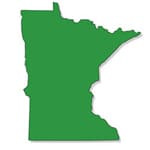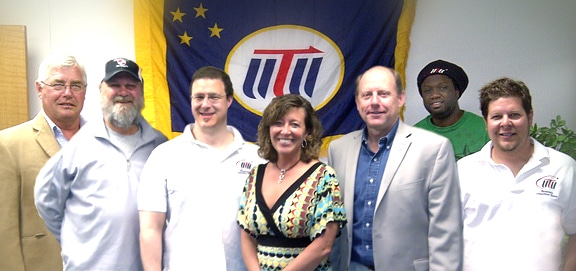
“The men and women in Minnesota and around the country that work in yard-switching operations should be able to see where they are walking. This is a great step forward and will become a model for many other states’ consideration,” SMART Transportation Division President John Previsich said.
Added Transportation Division National Legislative Director James Stem: “Phil Qualy and our Minnesota Legislative Board understand the needs of railroad workers. Congratulations to them on their great work on behalf of their members.”
“The legislative board would be remiss if we did not report to our membership that from the carrier’s testimony before the legislature, it is difficult not to conclude that while the railroads want to talk about safety, they do not want you to have yard lighting,” Qualy said. “We will see how the carriers react to enactment of the Railroad Yard Lighting law. Their actions will reveal management priorities and how corporate financial budgeting will be targeted.”
In summary, the new law puts in place the following provisions:
1.) Sets the AREMA (American Railway Engineering Maintenance of Way Association) policy as a minimum standard and guideline for future lighting of rail yards;
2.) Sets a maintenance standard that malfunctioning lighting must be repaired to Minnesota Electrical Code within 48 hours of first report to the carrier;
3.) Sets forth that annual reports from railroad carriers and railroad labor shall be submitted to the Minnesota Department of Transportation Freight Rail Office by Jan. 15. If there is any discrepancy between carrier and labor reports, MnDOT shall investigate and report the areas in question to the legislature, including what will be necessary to bring yards to the AREMA standard.
4.) Sets a standard for lighting review at locations where cars or locomotives are switched or inspected, or where trains are assembled or disassembled frequently.
5.) Prescribes that at any yard where hazardous material cars are switched, inspected, picked-up or set-out frequently, or 25 hazmat tank cars are placed in trains frequently, or any yard within two miles of a major refinery where hazmat is placed in a train, the yards must be lighted to the AREMA standard by Dec. 31, 2015.
“We can work with this state law,” Qualy said. “This should get our railroad yards in Minnesota lighted going forward in this decade. We deferred to the wisdom of the Minnesota Legislature and railroad labor has prevailed.”
Also contained in H.F. 3172 are statutes naming rail labor as participants in hazmat planning and training, the creation of three positions for MnDOT safety inspectors, and the “Minnesota Oil Spill Defense Act,” that will ensure public first responders are trained and equipped with fire and disaster equipment. MnDOT will also invest resources for grade-crossing improvements along high-density hazmat corridors.
Finally, H.F. 3172 appropriates transportation funding that has been traditionally spent on short-line rehabilitation projects to Class I railroad projects that will divert hazardous material away from population centers in western Minnesota.
House File 2881, the Railroad Crew Van provision, has also been signed into law and will strengthen our current crew-van statutes, Qualy said.
“With our second Railroad Crew Van law passed in Minnesota in four years, H.F. 2881 will raise standards for driver qualifications, carrier reporting of total hours of service, vehicle equipment standards and vehicle inspection requirements,” Qualy said. “We maintain our $5-million liability and $1-million uninsured and underinsured motorist provisions.”
Brotherhood of Locomotive Engineers’ Minnesota Legislative Director Dave Brown had been the primary advocate for H.F. 2881 – the Crew Van law. “It was good to work the BLET Director Brown as we remained focused on passage of these laws to the final day of the 2014 session. On behalf of our membership, I also want to thank Minnesota AFL-CIO Legislative Director Jennifer Schaubach, who was instrumental in finding a compromise for our yard-lighting legislation with an entrenched, obstinate, railroad lobby,” Qualy said.
The SMART TD Minnesota Legislative Board also, on the last day of the legislative session, worked with State Rep. Jason Metsa on the introduction of House File 3394, which would increase fines on carriers that intentionally block grade crossings. Qualy said train crews have reported that CN Railway train dispatchers continue to order train crews to not cut or open grade crossings. “Hopefully, they will discontinue these illegal directives,” Qualy added.
“The Minnesota Legislative Board extends its appreciation to all SMART-TD officers who testified before the legislature, our SMART TD National Legislative Office, SMART TD’s Iowa and North Dakota Legislative Boards, the officers of our BNSF, CN, Canadian Pacific and Union Pacific general committees of adjustment, our political consultant Dean Mitchell of DFM Group, and our SMART TD designated legal counsel – along with Larry Mann – all of whom really stepped-up to assist us in these efforts. We are also grateful to all of our members who made telephone calls to assist in this effort.
“As SMART Transportation Division-represented employees, we are also Minnesotans first,” Qualy added. “With the close of this two-year legislative cycle, our SMART TD and Minnesota AFL-CIO Working Family Agenda has moved the safety and security of our membership forward in a positive and productive manner. Our state of Minnesota is doing well and we look forward to the election season with optimism.
“Please contribute to your Minnesota UTU PAC. Your political voice is an essential investment in your future. Each member’s small contribution makes one large voice for transportation labor. UTU PAC does not cost, it pays.”
The individuals above attended legislative hearings for, testified about, or worked in support of the passage of H.F. 3172, Minnesota State Legislative Director Phillip Qualy said. They are, from left, retired former Assistant State Legislative Director Dan Paradise (1614), Local President George Armstrong (650), Local Chairperson Randy Raskin (650), Minnesota AFL-CIO Legislative Director Jennifer Schaubach, Qualy, Local Legislative Rep. Wayne Newton (1000) and Local Legislative Rep. Matt LaBine (650). (Not pictured are member Mike Heffernan (650) and Political Consultant Dean Mitchell, DFM Research Group).
